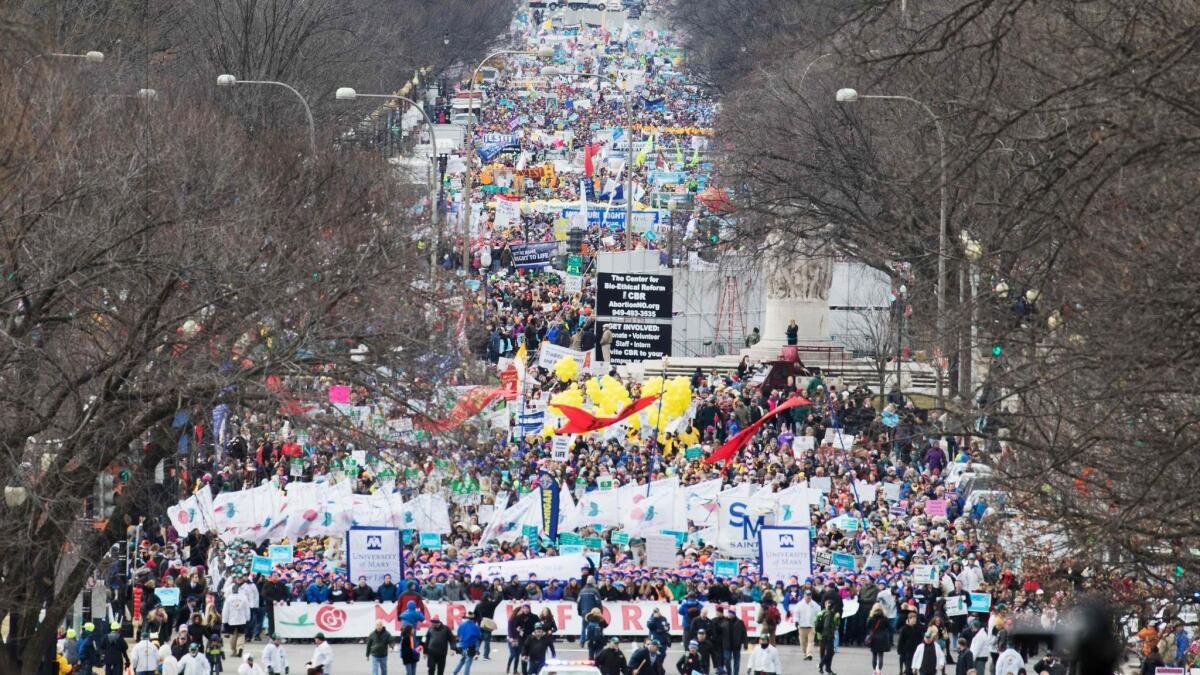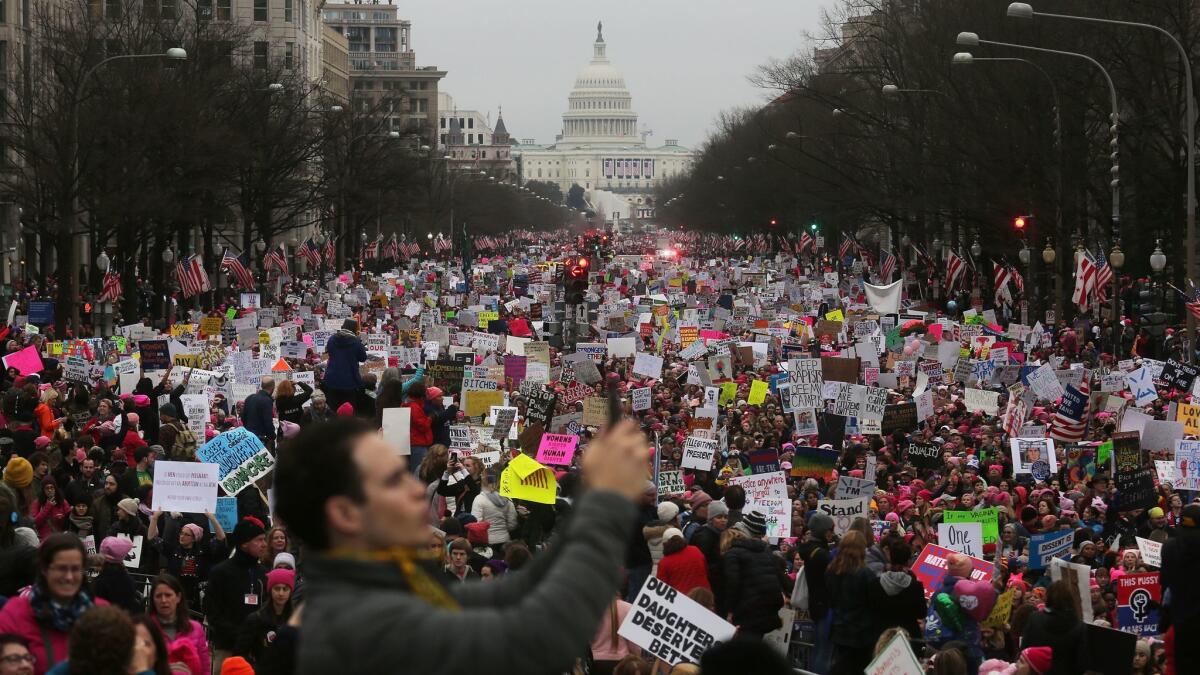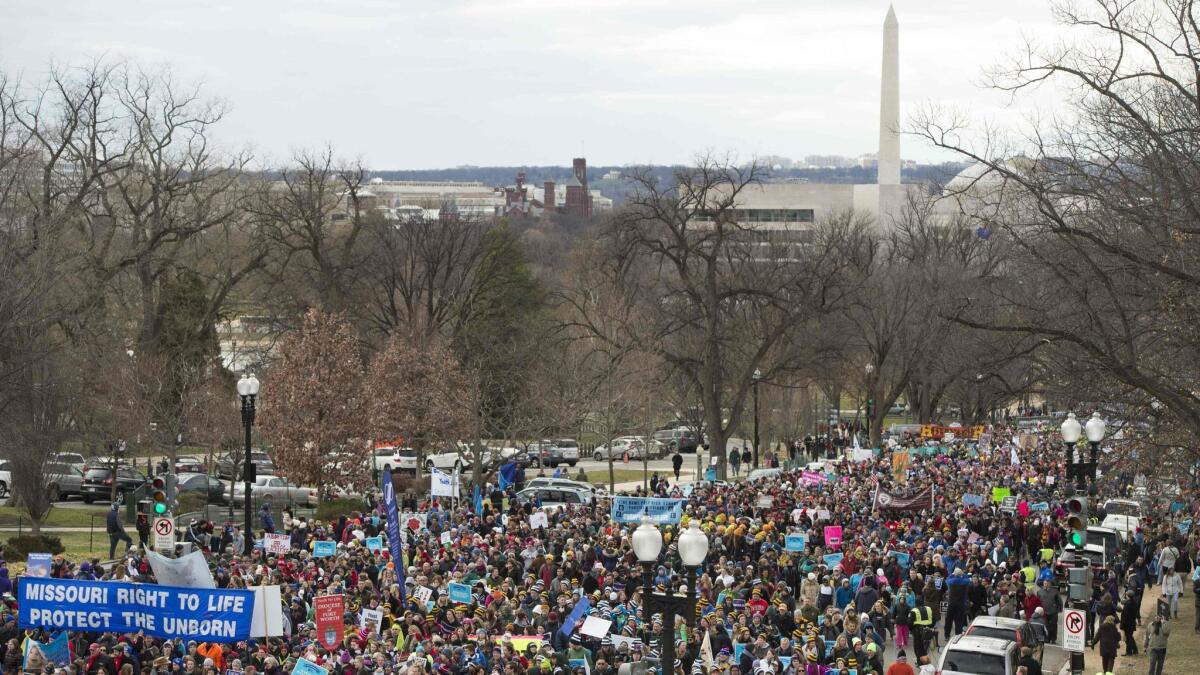Analysis:: Crowd sizes become the latest disputed measuring stick in a divided (and confused) America

- Share via
For the past two years, a divided America has been on a desperate quest to figure out which political world view is most popular, and thus more powerful, and thus rightfully in control of the nation’s future. We apparently still don’t have an answer.
There were the seemingly endless presidential polls, the election predictors like FiveThirtyEight.com, and, of course, Donald Trump himself, who bragged about his rallies and his TV ratings. Whatever it was, bigger numbers were better: They indicated momentum for the biggest opinion poll of all on Nov. 8.
Except Trump’s presidential victory has come and gone, and in a sign of how fractious things have gotten, the quest for quantification rages on: Crowd sizes have lately become one of America’s most important opinion polls, the latest metric to measure the turbulent political winds blowing through the country.
Over the course of just one week, the National Mall in Washington has held three large political gatherings, each representing three huge constituencies, with each trying to demonstrate popular legitimacy and influence.
Trump supporters made their showing first, on Inauguration Day, as an estimated couple of hundred thousand supporters gathered in front of the U.S. Capitol to watch and hear him become president.
Facing historically low approval ratings for a new president, Trump has tried to argue that his inauguration was the most-watched of all time. He also reportedly pressured the National Park Service to find photos showing that his crowd wasn’t smaller than the gargantuan crowd at Barack Obama’s first inauguration in 2009, and he continued to litigate the issue in the media.
“I looked out, the field was, it looked like a million, million and a half people,” Trump said in an appearance at the CIA on Jan. 21, complaining about media coverage that had accurate reflected the attendance of his swearing-in. “They showed a field where there were practically nobody standing there. And they said, ‘Donald Trump did not draw well.’ … It’s a lie.”
A day after the inauguration, America’s left responded in force, with millions gathering for a massive Women’s March, on the Mall in Washington and in cities around the country. An estimated 500,000 alone marched in Washington.
Many of those marchers saw Trump as an illegitimate president: a candidate who received almost 3 million fewer votes than his Democratic opponent, Hillary Clinton. Many also saw the march as new, quantitative evidence of Trump’s unpopularity.
“The President is not America. We are America!” actress America Ferrera declared to the crowd.

Some conservatives tried to downplay the massive display in D.C. “It’s almost as if one party has a base of wealthy coastal elites who can travel easily and the other does not,” tweeted Conn Carroll, the spokesman for Republican U.S. Sen. Mike Lee of Utah.
Amid all this, on Friday, America’s religious right, which largely supported Trump, swam into the political cataracts as at least tens of thousands gathered for the annual March for Life at the foot of the Washington Monument. (Some photographs suggested the march was smaller than the Women’s March crowds, though there were no official counts.)
The March for Life is typically the largest conservative demonstration of the year, a gathering held to rally opposition against the U.S. Supreme Court’s landmark Roe vs. Wade ruling in 1973, which defined women’s legal right to abort a pregnancy.

It’s been a good year generally for conservatives opposed to abortion. They stand to pick up a conservative Supreme Court justice and have seen one of their champions, Mike Pence, ascend to the vice presidency.
Yet many on the right had watched the widespread news coverage of the earlier Women’s March and wondered why their own annual march doesn’t get more attention from the media.
“When you looked at how much the networks covered the Women’s March even before it happened, they served as press agents for the Women’s March, and turned around and said, ‘Look at how successful this was, look how many people attended,’” said Dan Gainor, vice president of the Media Research Center, a conservative watchdog that has pushed for more mainstream television coverage of the March for Life. “That seems a tad unfair.”
Gainor pointed to polling showing that Americans are more likely to call themselves conservative than liberal or moderate.
“Is CNN going to go live for the whole March for Life? Is ABC going to run an endless live-stream shot? That’s the problem here,” Gainor said. “This is a big event ... the biggest conservative rally of the year, and we struggle to get coverage for it at all.”
Yet some recent polling also shows that public support for abortion legalization is at its highest point in two decades, largely driven by increases in support among Democratic women.
Kristina Hernandez, a spokeswoman for Students for Life, a group that opposes abortion, said about 50 of its members had attended the Women’s March and felt “vastly outnumbered.”
“The reaction to the Women’s March has overwhelmingly been, ‘If this is what feminism looks like, I want no part of it,’” Hernandez said.
Ann Grimes-Essay, 56, from Pittsburgh braved the cold Friday to join the March for Life, which she had first attended when she was 14.
She, too, had heard about the Women’s March and how an anti-abortion women’s group had been prevented from joining the leadership, and she called that “a slap in the face to women who believe in respecting all life.”
Because of that, Grimes-Essay said, “I really think that for most pro-lifers it was very important that we make a stand, to say that we’re still here.”
And so she made her stand, gathering among the thousands to be heard, and to be counted.
Times staff writer Cathleen Decker in Washington, D.C. contributed to this story.
ALSO
Trump’s actions on Obamacare threaten to undermine insurance markets
Trump signs order to temporarily shut nation’s door to most refugees and start ‘extreme vetting’
More to Read
Sign up for Essential California
The most important California stories and recommendations in your inbox every morning.
You may occasionally receive promotional content from the Los Angeles Times.














